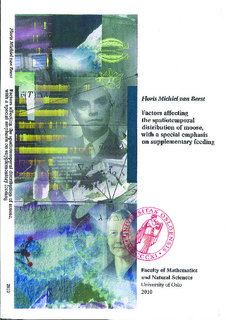| dc.contributor.author | van Beest, Floris Michiel | |
| dc.date.accessioned | 2011-02-28T14:03:27Z | |
| dc.date.available | 2011-02-28T14:03:27Z | |
| dc.date.issued | 2010 | |
| dc.identifier.citation | van Beest, F.M. (2010). Factors affecting the spatiotemporal distribution of moose, with a special emphasis on supplementary feeding. Oslo : Universitetet i Oslo | en_US |
| dc.identifier.issn | 1501-7710 | |
| dc.identifier.uri | http://hdl.handle.net/11250/132012 | |
| dc.description | Doktorgradsavhandling ved Universitetet i Oslo ved det matematisk- naturvitenskapelige fakultet, nr 1016. | en_US |
| dc.description.abstract | Large herbivores constitute an important natural resource and are actively managed to
meet economic, conservation and environmental objectives. To alleviate the potential of
resource limitation and damage to commercially important habitats in areas with high
population densities, the provisioning of artificial or supplementary forage has become a
popular wildlife management intervention throughout Europe and North America.
However, the usefulness of supplementary feeding is equivocal and little is known about
how it affects spatiotemporal distribution patterns of large herbivores.
The main aim of this thesis is to quantify the effect of supplementary feeding on
the spatiotemporal distribution of moose (Alces alces L. 1758) living in southern Norway.
I used locations of free-ranging GPS (global positioning system) collared moose (N = 26
in summer and N = 32 in winter) with access to supplementary feeding stations to
estimate habitat selection and home range size as a function of feeding status (i.e. feeding
station users vs. non-users), variation in browse quantity and quality, and also in terms of
local climate and individual characteristics. To evaluate fine-scale distribution patterns
and foraging decisions around supplementary feeding stations I employed 2 independent
datasets (GPS data and browsing estimates) from two study areas (in Telemark and
Hedmark counties) that differ in the length of their feeding history. I apply central-place
foraging theory to explain the observed patterns.
My results indicate that supplementary feeding affects the spatiotemporal
distribution of moose only at intermediate to fine spatial scales during winter, with
feeding station users behaving as central-place foragers. However, feeding station users
did not differ in their large-scale habitat selection patterns or home range size compared
to non-users. Instead, moose habitat selection was driven by a scale-dependent trade-off
between browse quantity (landscape-scale) and browse quality (within-home rangescale).
Moreover, depletion of high quality browse during winter lead moose to increase
selection for lower quality browse within their home range. Variation in home range size
was affected by several extrinsic (i.e. climate and natural browse) and intrinsic variables
(i.e. individual characteristics) and their effects varied between and within spatiotemporal
scales. After 6 years of feeding, moose that used feeding stations selected for
commercially valuable browse (i.e. Scots pine) within their home range to the same
extent as non-users, which questions the effectiveness of winter feeding in reducing
browsing pressure over large spatial scales. In addition, as the time scale of feeding
increased from 5-10 to 15-20 years, browsing pressure on commercially valuable browse
(i.e. Scots pine and Norway spruce) was amplified at a fine spatial scale. At the same time, resource depletion in the vicinity of feeding stations lead moose to forage at
increasing distances from feeding stations and browsing damage occurred at least up to 1
km from feeding stations. These findings suggest that when supplementary feeding is
practised over longer time scales (more than 20 years) there is the potential for a trade off
to occur between the energetic cost of returning to the central-place (i.e. feeding station)
and the energetic benefits it provides.
Evaluating management actions is important to determine whether the objectives
and desired effects are realized. I have shown how supplementary feeding can affect the
spatiotemporal distribution of moose and how subsequent browsing pressure around
feeding stations can change over time. However, there are a variety of direct and indirect
effects that follow the provisioning of supplementary forage that have not yet been
adequately assessed. A holistic evaluation of the effectiveness of supplementary feeding
as a wildlife management tool is required and needs to consider all the associated benefits
and costs, especially considering long-term developments and potential ecosystem-level
effects. | en_US |
| dc.language.iso | eng | en_US |
| dc.publisher | Universitetet i Oslo | en_US |
| dc.subject | large herbivores | en_US |
| dc.subject | management | en_US |
| dc.subject | moose | en_US |
| dc.title | Factors affecting the spatiotemporal distribution of moose, with a special emphasis on supplementary feeding | en_US |
| dc.type | Doctoral thesis | en_US |
| dc.subject.nsi | VDP::Mathematics and natural science: 400::Zoology and botany: 480 | en_US |
